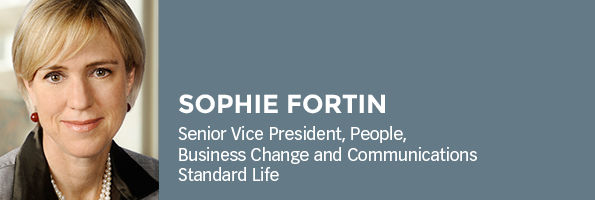
Navigating change in a complex industry
Sophie Fortin is a high-level executive with an outsider’s point of view. The senior vice president has a rather complex and broad mandate to live up to, as well.
Charged with the task of leading change, managing talent, and implementing a high-performance culture when she was hired six years ago, Fortin also has responsibility for the company’s project management office – overseeing every project launched to support Standard Life’s larger business plans.
“It’s a bit unusual to have the business change or project management office reporting to human resources, but it does get people talking (to each other), so that’s good,” she says.
With technology, things move so fast, we often don’t have time to just stop and think. But we need to do that.
The human resources veteran with more than 25 years of experience in the pharmaceutical and manufacturing industries, says financial services is fascinating because of its complexity, but also because the people tend to be passionate and educated. “They really know their industry, and they’re curious.”
The challenge for human resources, meanwhile, is to meet and connect with business needs, as opposed to being somewhat insular in its activities. “You can have a lot of fun programs,” she says of those like personnel development or others which might be the norm from a human resources point of view, “but they need to answer a business need. How does it support the business?”
“I think that’s what an HR department is there to do – it’s a little bit compensation and benefits, but a lot of it is making the organization grow, and (stay) stable.”
Her view of talent management, meanwhile, is decidedly clear and informed. Job rotation as a means of developing talent is a concept that is more frequently a topic of interest in the industry, one that is being implemented with varying degrees of success. Fortin though, is able to place the idea and discuss its effectiveness in a broader context, as well.
“The new generation coming in, up into their mid 30s, they want to move around, much more than the older generation,” she says. “So I think organizations need to find ways to move them around. They can’t move up all of the time.”
While job rotation is something done within departments at Standard Life, she points out that companies also need to have an infrastructure in place to pull it off, or employees will begin to wonder if they have a job at the end of their new placements.
A lot of the change being navigated by insurance companies today is technological. With that in mind, it begins to make sense that Fortin would also be charged with the task of overseeing project management within the company.
“How do we make changes rapidly enough, because that’s the world we’re in, while still providing some stability to employees? With technology, things move so fast, we often don’t have time to just stop and think. But we need to do that,” she says.
“We need to adapt, and at the same time give people chance and time to change. That’s a challenge,” she adds, but one which needs to be addressed. “Change is really constant. It will never go away.”



